- Pūrongo ā-Tau 2022-23
- SECTION 1
Our year in review - SECTION 2
Making New Zealand better for New Zealanders - SECTION 3
A high-performing organisation and a great place to work - SECTION 4
Māori-Crown Relations Capability - SECTION 5
Carbon Neutral Government Programme - SECTION 6
Annual Report of the Ministry for Ethnic Communities - SECTION 7
Digital Executive Board Annual Report 2022/23 - SECTION 8
Financial and non-financial results - SECTION 9
Appendices - SECTION 10
Glossary (Appendix E)
- SECTION 1
Go to the Contents View or download the PDF version Go to the next section
2. E ora ai a Aotearoa, ka ora ai tātou
Making New Zealand better for New Zealanders
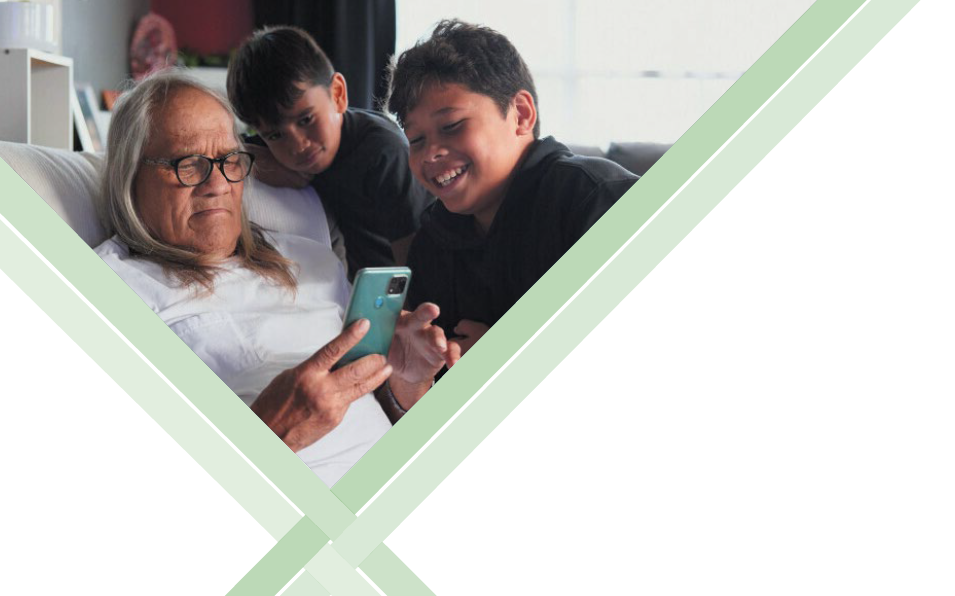
About this section
As a large and complex department, we take many actions every day that positively impact our five outcomes. This section explains our Outcomes Framework and the work Te Tari Taiwhenua carried out in 2022/23 to contribute towards the achievement of our outcomes.
He papa whāinga
Our Outcomes Framework
Our Strategic Intentions 2021–2025[1] describes our Outcomes Framework. We continue to develop and refine our organisational strategy, Ā Mātou Mahi. This strategy includes our purpose, five outcomes and our priorities for making a difference over time for people and society. Our outcomes are encompassed by the following statement, which reinforces our commitment to and encourages better understanding and capability of te ao Māori.
Whāia te hīnātore o te mauri atua, hei oranga mō te mauri tāngata
The pursuit of environmental sustenance and potential enhances the wellbeing
and life essence of people and place.
Oranga hapū, iwi and Māori is improved through an enduring, equitable and positive Māori-Crown partnership
Iwi, hapū and communities across New Zealand are safe, resilient and thriving
People's sense of belonging and collective memory builds an inclusive New Zealand
New Zealand is a well-functioning democracy across central and local government
People can easily access the services and information they need
1. A copy of the 2021–2025 Strategic Intentions document can be found at https://www.dia.govt.nz/Strategic-Intentions
Outcome indicators and performance measures
Te Tari Taiwhenua uses outcome indicators to demonstrate the impact of the work we do to benefit New Zealand and those who live here. We use statistical surveys and other research from local and international sources to see whether trends over time represent good progress towards achieving the outcomes. We consider the trend of results over the medium and long term (five or more years) to be more informative than minor changes from one year to the next. Indicators can only illustrate an aspect of an outcome and the partial influence of Te Tari Taiwhenua.
To the extent that we can, we show the trend in movement. We use the following legend to indicate whether the outcome indicator trend is increasing, being maintained or decreasing.
Legend for outcome indicators
![]()
Trend is increasing (positive).
![]()
Trend is being maintained. Movements from one year to the next are statistically insignificant.
![]()
Trend is decreasing (negative).
Our performance measures are reported in Section 8 Non-Financial Performance Statements. These performance measures assess whether we have achieved specific services or functions that collectively support the overall achievement of our outcomes.
Budget significant initiatives
Te Tari Taiwhenua received funding for the following Budget significant initiatives through Budget 2023 (impacting 2022/23), Budget 2022, Budget 2021 and/or Budget 2020:
- Establishing the Ministry for Ethnic Communities
- Future for Local Government
- Royal Commission of Inquiry Into Historical Abuse in State Care and in the Care of Faith-based Institutions
- Royal Commission of Inquiry Into Lessons Learned From Aotearoa New Zealand's Response to COVID‑19 That Should Be Applied In Preparation For Any Future Pandemic
- Supporting natural hazard and weather events
- Tāhuhu: Preserving the Nation’s Memory Programme
- Te Ara Manaaki Programme
- Water Services Reform – new Water Services Entities
- Water Services Reform – Taumata Arowai.
Appendix A outlines where performance information can be found on these Budget significant initiatives.

Outcome:
Kua whakapai ake te oranga o ngā hapū, o ngā iwi me ngā tāngata Māori mā tētahi hononga matatū, e tōkeke ana, he ngākaupai anō hoki i waenga i ngāi Māori me te Karauna
Oranga hapū, iwi and Māori is improved through an enduring, equitable and positive Māori-Crown partnership
About this outcome
Te Tari Taiwhenua has significant and diverse responsibilities that require strong partnerships, engagement and consultation with Māori to be effective. This outcome was created to recognise this need.
This outcome places our relationship with hapū, iwi and Māori at the centre of our decision-making. It requires us to build our capability in te ao Māori, te reo me ōna tikanga and Te Tiriti to help achieve improved, enduring and equitable outcomes for Māori.
The term ‘oranga’ can be translated as wellbeing but from a te ao Māori perspective it encompasses much more, including the connection between people’s health and wellbeing and the whenua (land) and taiao (environment) around them. Our overarching statement Whāia te hīnātore o te mauri atua hei oranga mō te mauri tāngata supports all our organisational outcomes, particularly the oranga outcome, as it anchors us in a te ao Māori way of thinking and gives prominence to mātauranga Māori.
Contributing to the achievement of this outcome we have two intermediate outcomes that represent more specifically the impact we will have:
- Mātauranga Māori is respected and valued
- Māori, iwi and hapū aspirations, interests and rights are understood and respected.
Case study
Improving our partnership with Māori to record iwi affiliation information
Our aim
Our aim is to work in partnership with Māori to explore an opportunity for Te Tari Taiwhenua to support the needs of Māori around recording iwi affiliation information.
Our role
The role of the Registrar-General of Births, Deaths and Marriages is to be the trusted keeper of records of life events for the people of New Zealand. Recently, this has included working with a Māori decision group, Te Kāhui Tātai Tupuna, to consider how best to meet Māori needs around recording iwi affiliation information.
This information has critical value for wellbeing, identity and linkages to Māori people and land. There is an opportunity to invite whānau to record this information when they register a birth or death, and this can include the nominated iwi validating the claimed affiliations, where the whānau want this to happen.
The outcome
Te Kāhui Tātai Tupuna produced a report, He Tātai Tupuna, that set out a Tiriti partnership-based model (the model) for iwi affiliation information. This report was endorsed by the National Iwi Chairs Forum at Waitangi in February 2023. The work of Te Kāhui Tātai Tupuna has been accompanied by regular updates to all iwi and a range of Māori organisations, inviting feedback and input to the thinking.
Te Tari Taiwhenua is working with Te Kāhui Tātai Tupuna to co-design an implementation pathway for the model. The requirements are that this must be developed in a positive Tiriti partnership, and that the status of iwi affiliation information as mātauranga Māori must be reflected in this design.
What this means for New Zealanders
This Tiriti-based initiative to build the model for recording iwi affiliation information will ensure that this information is governed by, and used for, the benefit of Māori. In the longer term, this will provide identity, wellbeing and connection benefits for Māori and equity benefits for Aotearoa New Zealand.
Supporting mana whenua and councils to create more reorua (bilingual) towns and cities
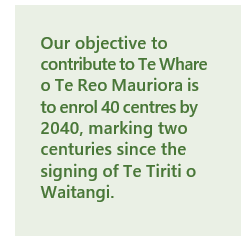 Our Aotearoa Reorua programme supports councils and their mana whenua partners to create more spaces, places and opportunities where te reo Māori is seen, heard and celebrated. Together, councils and mana whenua co-design a strategy that reflects what’s special about their community, such as local pūrākau (stories) and reo ā-iwi (dialects).
Our Aotearoa Reorua programme supports councils and their mana whenua partners to create more spaces, places and opportunities where te reo Māori is seen, heard and celebrated. Together, councils and mana whenua co-design a strategy that reflects what’s special about their community, such as local pūrākau (stories) and reo ā-iwi (dialects).
We continue to support nine bilingual centres: Ahuriri-Napier, Kerikeri, Ōpōtiki, Ōtaki, Porirua, Rotorua, Te Wairoa, Tokoroa and Whakatāne. Each centre designs a strategy uniquely suited to their own community’s needs and aspirations. This provides a unique platform for councils and mana whenua to work together towards a common goal and where such partnerships are enhanced. We anticipate to onboard three more centres by December 2023.
We developed this programme with support from Te Taura Whiri i te Reo Māori, Te Puni Kōkiri and Te Mātāwai as part of our commitment to protect and strengthen the status of te reo Māori in Aotearoa New Zealand.
Parihaka Māra Kai Rōpū – supporting whānau to access free, fresh and healthy kai
A local community group, Te Māra Hapori ki Parihaka Topu, was awarded a $10,000 grant from the Community-Led Development Small Initiatives Fund in December 2022. The group oversees work in a large community garden, located on the Parihaka Papakāinga.
The grant helped to manage work at te māra kai to enable an increase in planting and harvesting of kai and distribution of kai to the wider rural community. The grant also supported Te Māra Hapori ki Parihaka Topu to increase their ability to provide fresh food for papakāinga residents, the three Parihaka marae and whānau within the local community.
As the cost of living continues to rise, the improvement in local kai resilience is a key focus for many communities. The group recorded a total harvest that included 1,090 kilograms of potatoes and 310 kilograms of kumara for the season. This demonstrated the size of their māra kai and the group’s ability to support whānau to access free, fresh, healthy kai for meals. This small but valuable grant has been enabled through a flexible funding approach and the group’s relationship with our local office.
Supporting iwi/Māori in their involvement in water services reform
During the year, 54 applications received He Pūkenga Wai funding support. The aim of the fund is to support post-settlement governance entities, and mandated iwi organisations and iwi authorities, to engage with their whānau, hapū and iwi on the water services reform. Across New Zealand, a diverse range of activities were supported, including hui and wānanga, project planning, undertaking research and analysis, preparing submissions, and engaging expert or technical advice.
Te Manawa o Ngā Wai is one of the largest iwi collectives to receive Seed and Iwi Collective funding from Te Tari Taiwhenua. Comprising 63 iwi across Tainui, Te Arawa and Mataatua rohe, funding support has enabled the establishment of a Secretariat, and for the iwi to participate and engage across all parts of the water services reform.
The focus of the Secretariat over the past 12 months has been engagement and information sharing, representation and participation in the transitional workplan. During this time, 24 hui-a-iwi were delivered across four waka-a-rohe, which assisted in the following key outcomes:
- Establishment of a board of representatives for Te Manawa o Ngā Wai
- Scoping of priorities and opportunities, which led to the development of the Te Manawa o Ngā Wai Workplan
- Nomination and participation of representatives on the asset management and marae and papakāinga national working groups
- Advice and support for iwi and hapū to lodge submissions on the water reform legislation
- Support to iwi and hapū to develop Te Mana o Te Wai statements
- Further support to iwi and hapū in undertaking marae and papakāinga infrastructure needs assessments.
Case study
Supporting Māori to access taonga in Archives New Zealand and National Library care
Our aim
Our aim is to support the culture and heritage aspirations of Māori and recognise their unique rights and interests to taonga held in the care of Archives New Zealand and the National Library (the institutions).
Our role
Our role is to give access and opportunities for Māori to directly engage with their taonga. This includes working in collaboration with other culture and heritage agencies such as Te Papa Tongarewa, Manatū Taonga and Heritage New Zealand Pouhere Taonga. This helps to collectively respond to aspirations for their people and share knowledge and expertise, and also includes supporting Māori capability growth in the archiving and preservation of taonga.
During the year, the institutions have:
- hosted several iwi to engage with their taonga, develop archiving and preservation plans, and engage in conversations about how we can better support their aspirations in a practical way
- provided advice on the development of iwi whare taonga, including input into building design and content development
- digitised records of significance, such as Māori Land Court minute books, making them accessible beyond the institutions
- worked in partnership with Ngā Taonga Sound & Vision to host an iwi conference that provided iwi archivists with hands-on opportunities to grow their archival capabilities.
The outcome
The institutions are connected to iwi and their aspirations, which helps kaimahi at Te Tari Taiwhenua understand how their work contributes to iwi strategic plans and goals. The institutions help to strengthen their delivery of service to Māori and the Māori-Crown partnership.
What this means for New Zealanders
Māori can engage with their taonga, connect with their own stories and provide greater context to taonga. This supports a richer and fuller picture of who we are as a nation, our collective history and the importance of strengthening the Māori-Crown partnership
Delivery snapshots
Te Whakatinanatanga o Te Tiriti o Waitangi, a workbook for public
servants about the Treaty of Waitangi, was launched in May 2023 as a
companion to the He Tohu exhibition at the National Library
(https://natlib.govt.nz/he-tohu)
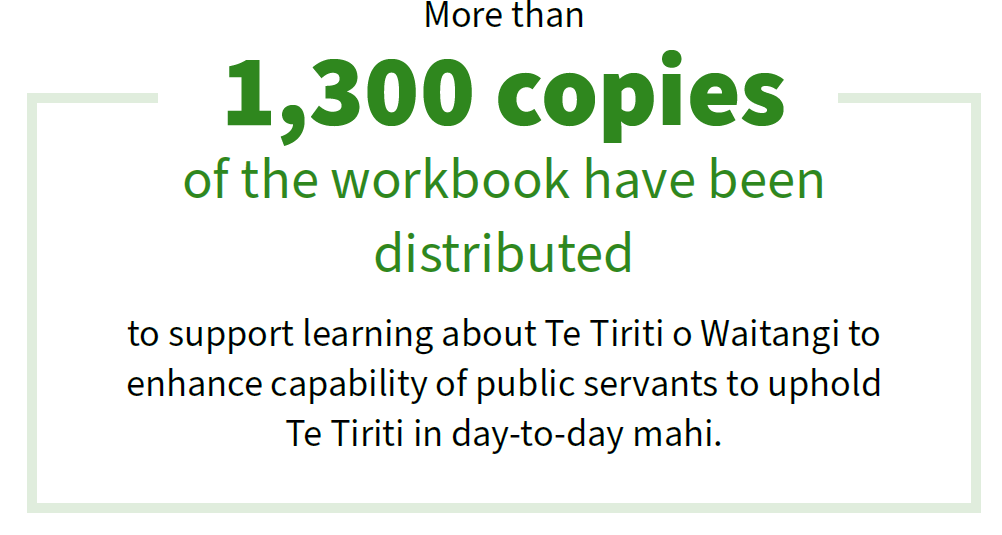
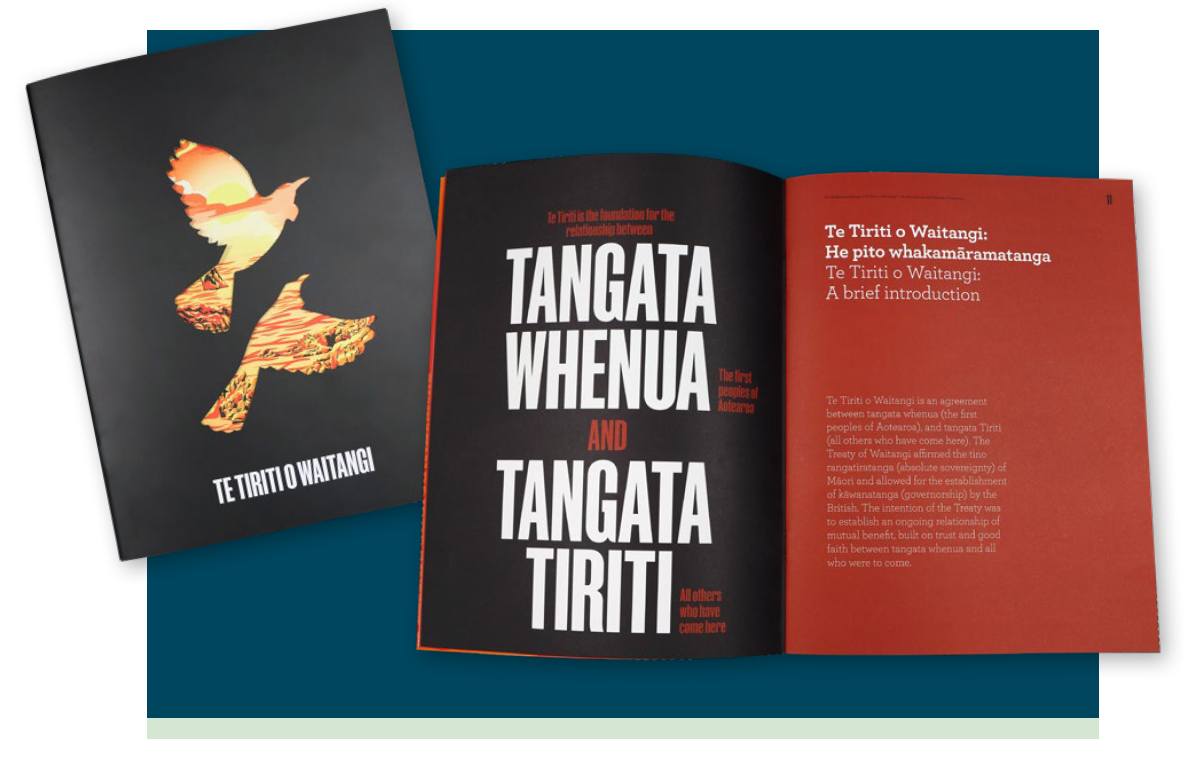
What are our outcome indicators telling us?
Te Tari Taiwhenua has started to measure progress for this outcome. We talked to people inside and outside of Te Tari Taiwhenua about their thoughts on the most important aspect for this outcome. We found a high-quality Māori-Crown partnership to be a common theme that was talked about.
Ongoing partnership should be close and durable. This means that when steering and navigating a waka, one partner knows the skill needed to hold the urungi (rudder), while the other knows what environmental signs to share to reach our destination, and vice versa. A high-quality Māori-Crown partnership includes having strong Māori leadership within Te Tari Taiwhenua. Where Māori are involved in decision-making and/or the leadership of services, there are positive results for whānau, hapū, iwi and Māori.
We will measure progress against this outcome by first monitoring the level of Māori leadership within Te Tari Taiwhenua so we can see how our own capability grows over time. This indicator is Māori leaders in Te Tari Taiwhenua at tier 4 level and above is maintained or increased.
We have also identified that we need to understand the quality and state of our engagement with hapū, iwi and Māori across our diverse work. This in turn will help us understand the importance of building relationships to progress our Treaty settlement commitments. We are considering ways to capture and monitor these views.
▶ Māori leaders in Te Tari Taiwhenua at tier 4 level and above is maintained or increased [1]
|
Metric |
2018/19 |
2019/20 |
2020/21 |
2021/22 |
2022/23 |
Trend |
|---|---|---|---|---|---|---|
|
% |
New indicator |
13.2%(20 people leaders) |
14.3% (25 people leaders) |
13.1% (24 people leaders) |
|
|
Source: DIA
Our indicator result shows the percentage of Māori leaders at tier 4 level and above for the past three years has largely been maintained. When we look at the actual number of tier 4 Māori leaders, we see that this has grown since 2020/21, and then stabilised. This year we placed leadership roles in Te Urungi, the Māori, Strategy and Performance branch. Te Urungi is the new branch responsible for the organisation’s strategy and performance functions at national level and leads work on Te Tiriti obligations and internal cultural competencies. You can find more information on the establishment of Te Urungi branch under our Māori-Crown Relations section of this annual report.
1. Tier 4 and above is defined as the top four tiers of managers and leaders that lead people within Te Tari Taiwhenua with the Chief Executive being tier 1.
Return to He papa whāinga - Our Outcomes Framework

Outcome:
Kei te haumaru, kei te pakari, kei te ora te hunga o Aotearoa
Iwi, hapū and communities across New Zealand are safe, resilient and thriving
About this outcome
Communities are important to people’s wellbeing. People have the best opportunity to thrive and prosper when the communities they live in are safe and resilient.
Communities can be supported to manage risks and challenges and empowered to form and realise their own aspirations, despite adversity they might face over time.
The aspirations of iwi, hapū and Māori are important for social wellbeing, and the Crown has a responsibility to support those aspirations as a partner in the Treaty of Waitangi.
Resilient infrastructure is important to communities and their long-term wellbeing. Addressing the planning for and funding of infrastructure ensures communities have the facilities that allow our regions to thrive and prosper.
Contributing to the achievement of this outcome we have three intermediate outcomes that represent more specifically the impact we will have:
- Regulated activities minimise harm and maximise benefits to people and communities
- Māori are supported to realise their aspirations
- Communities are supported to develop and prosper.
Case study
Supporting community wellbeing through local government investments
Our aim
The ‘3 Waters Stimulus Investment’ is an initiative to stimulate recovery from COVID-19 and help reform under-pressure water services to a more sustainable footing.
Our role
Te Tari Taiwhenua provides the local government sector with funds that support the upgrade of under-pressure water services. We appointed Crown Infrastructure Partners to monitor the delivery of this initiative.
The outcome
The initiative was announced on 8 July 2020 and was designed to support the economic recovery from COVID-19. It was completed by the end of December 2022 and delivered 291 kilometres of drinking water pipe upgrades, 160 kilometres of wastewater pipe upgrades, 101 drinking water treatment plant upgrades and 128 wastewater treatment plant upgrades.
For example, the Whakatāne District Council: Headworks Paul Road aimed to provide resilience for the Otumahi water supply.
The project has seen the headworks for the second bore installed together with the integrated control systems between the new and existing bore. The integrated control systems enable a duty/standby operation and uninterrupted flow if one bore is out of action due to a fault, maintenance or unforeseen issues.
The new treatment plant incorporates UV treatment, reducing the risk of possible protozoa infection. The project was progressed to improve the resilience of the Paul Road water supply and to align the network with a possible long-term option of supplying water to the Whakatāne township.
Information about the completed projects can be found on the Crown Infrastructure Partners website at https://www.crowninfrastructure.govt.nz/water-infrastructure.
What this means for New Zealanders
These initiatives aim to keep our communities strong and healthy. The projects undertaken are important in supporting local councils to deliver infrastructure that, in turn, supports a more sustainable future.
Supporting communities in the wake of Cyclone Gabrielle and other weather-related events
Significant flooding events earlier this year, followed by Cyclone Gabrielle, have had a devastating impact on a number of communities, hapū and iwi across the country. Te Tari Taiwhenua worked closely with other government agencies, councils, non-government organisations and directly with communities, hapū and iwi. We provided information, resources and advice to communities and the administration of grant funding. Our work included:
- Responding to community need following a natural disaster
Te Karaka township was severely impacted by flooding and many whānau were displaced and relocated to Gisborne. Community members approached Te Tari Taiwhenua for funding assistance to enable their children and young people to remain connected to their school. Tairāwhiti-based community advisors from Te Tari Taiwhenua worked closely with iwi, hapū and communities, as well as other funders and agencies. Te Karaka Area School received a grant of $60,000 through the Lottery Emergency Natural Disaster Response Fund. This enabled the school to provide bus transportation for displaced children so they could continue to attend school and remain connected to their community. Dislocation and isolation are among the significant impacts of natural disasters. Assisting communities to stay connected in the wake of a disaster enhances recovery and builds resilience.
- Supporting whānau and communities to salvage and protect their taonga and important family collections
National Library kaimahi worked together with other agencies, including Te Papa Tongarewa and Heritage New Zealand Pouhere Taonga, to offer support in the rescue and preservation of taonga in devastated areas. This involved kaimahi working alongside communities, offering assessments, advising on treating affected collections, and attending online hui to support as many communities as possible.
- Supporting recovery from extreme weather events
The extreme weather events in the North Island were highly damaging and disruptive and we moved quicky to help with the initial response and the ongoing recovery. We enabled councils by supporting Parliament to change laws to make it easier for councils to focus on recovery work and distributed nearly $140 million to them to support recovery efforts. This funding included $137 million to manage sediment and debris removal. We also worked closely with councils to understand their needs and issues to support a successful locally-led recovery.
Partnering with our Pasifika neighbours to improve online safety
With broadband services increasingly available to many for the first time in the Pacific Islands, there has been a resulting increase in internet access. Te Tari Taiwhenua has been working to improve online safety in the Pacific by extending New Zealand’s Digital Child Exploitation Filter System to Samoa and Tonga. The filtering system blocks websites that host clearly objectionable child sexual abuse material. It helps to combat the trade in child sexual abuse material by making it more difficult for persons with a sexual interest in children to access that material.
To support this work, we signed a partnership agreement with the Government of Samoa in December 2022, and we are in the final stages of an agreement with the Government of Tonga. We have also been working with Internet Service Providers in the Pacific to test and implement the filter system with them. This work will keep online users in Samoa and Tonga safe by making it harder to access websites that contain child sexual abuse material.
Making Lottery grants funding more accessible
On behalf of the Lottery Grants Board, Te Tari Taiwhenua trialled a more responsive and accessible way of providing funding to hapū, iwi and communities, called Funding for Change. This initiative enables hapū, iwi and communities to access smaller amounts of funding when they need it, rather than waiting for a specific annual funding round. Funding for Change empowers Lottery Committees to be more proactive in how funding is allocated to community groups and projects.
Funding for Change continues to be led by community advisors in Hāpai Hapori, a team within Te Tari Taiwhenua. These advisors seek out initiatives from hapū, iwi and communities who do not regularly access Lottery funding or innovative projects. These projects could bring positive change to a community or group of community organisations. In 2022/23, this more flexible funding approach provided 94 grants. Of these, 29 percent supported organisations new to Lottery funding, 41 percent supported Māori to achieve their aspirations and 14 percent supported Pasifika to achieve theirs.
Legislation and regulation that makes a difference to communities
In 2022/23, Te Tari Taiwhenua progressed legislation and regulations in three key areas:
- The Fire and Emergency New Zealand (Levy) Amendment Bill was passed in April 2023. The implementation of a new levy to fund Fire and Emergency New Zealand will occur on 1 July 2026, ensuring the organisation can continue providing services crucial to the safety of our communities.
- Class 4 gambling harm minimisation regulations are now in place. These regulations introduce new requirements in all Class 4 venues for staff training, venue design and monitoring gamblers for signs of harm. The Regulatory Services group within Te Tari Taiwhenua is working with the sector on effective implementation.
- The Charities Amendment Act was passed in June 2023. The Act makes it easier for registered charities to continue their valuable work in our communities, while maintaining public transparency and accountability.
Water Services Reforms
In April 2023, the Government announced changes to refocus its water services reforms. A key change was the moving from four to 10 new water services entities. On 16 June 2023, legislation was introduced to make these changes happen.
The Water Services Reform National Transition Unit (NTU) has been refocusing the water services reform work plan alongside the legislative process to help councils plan their future work and priorities. The NTU is continuing to work with council officers, iwi collectives and formally mandated organisations in each entity area to have discussions around the best dates to go live.
Te Tari Taiwhenua has begun to hire Chief Executives for the entities. As part of the NTU, the Chief Executives are supporting the work to stand up 10 entities. Entity A is set to go live on 1 July 2024, with the other entities going live at times agreed between Te Tari Taiwhenua and local representatives.
Once Entity A has its board appointed, the kaimahi of Entity A will move from Te Tari Taiwhenua to the entity. Entity A covers the Northland and Auckland regions. Between now and 1 July 2026, entities will each have their boards appointed and they will, in turn, hire their Chief Executive where one has not already been appointed.
Case study
Keeping people safe from online harm such as spam and scams
Our aim
We aim to help ensure iwi, hapū and communities across New Zealand are safe, resilient and thriving. Many New Zealanders, however, have been the target of serious scams over the past year. This is often in the form of text messages and emails supposedly from banks, government agencies and courier companies. Some people have lost tens of thousands of dollars to these scams, money they are unlikely to see again.
Our role
Our Digital Safety Group works with domestic and international agencies to protect New Zealanders from online harm, including from electronic scam messages. Over the past 12 months, we have received over 200,000 reports of scams, an increase of more than 9,000 percent since 2020.
Scammers are not having it all their own way and we are working hard to reduce the impact on New Zealanders. Our work encompasses protection, prosecution and education efforts. Traditionally, we investigate both nuisance messages and those that cause harm. In response to the increase in scams, we have shifted our focus to the most harmful messages.
We are working closely with mobile network operators, banks, the Police and CERT NZ to investigate the scams and prosecute the New Zealand-based offenders. We work closely with the likes of Netsafe, CERT NZ, the Telecommunications Forum and overseas partners who are doing similar work, such as the Australian Communications and Media Authority. This is to ensure our investigative and preventative approaches are effective, appropriate and coordinated.
This year, for the first time, we produced the Digital Messaging Transparency Report, which helps organisations working with digital messaging understand the trends and volumes of cyber-threats. Our 7726 SMS spam reporting services allows the public to report scams received by text message to Te Tari Taiwhenua free of charge. We have also increased efforts to raise awareness of serious scams by sharing messages through news media and social media and have reached over one million people.
The outcome
Scams are not likely to go away any time soon. As measures for early detection and prevention get more sophisticated, so do the efforts of the scammers. We are not deterred and continue to work with our local and international partners.
Being scammed used to be something to be ashamed of and it was not widely talked about. Thanks to efforts such as ours, scams are now discussed openly and tips to spot a scam are better known and shared widely.
What this means for New Zealanders
No-one deserves to have their privacy invaded and money stolen, regardless of the amount. We are working hard to ensure that New Zealanders know how to spot and report a scam so they can avoid them.

Delivery snapshots
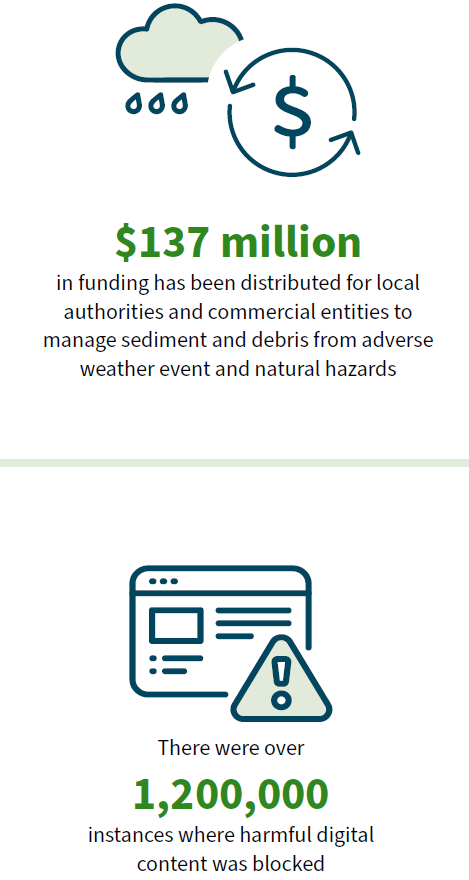
What are our outcome indicators telling us?
Overall life satisfaction is maintained or increases [1]
|
Metric |
2018/19 |
2019/20 |
2020/21 |
2021/22 |
2022/23 |
Trend |
|---|---|---|---|---|---|---|
|
% |
81% |
No survey |
85% |
81% |
81% [2] |
|
Source: General Social Survey – Stats NZ [3]
▶ Experience of discrimination decreases
|
Metric |
2018/19 |
2019/20 |
2020/21 |
2021/22 |
2022/23 |
Trend |
|---|---|---|---|---|---|---|
|
% |
17% |
No survey |
17.5% |
20.9% |
Data not available [3] |
|
Source: General Social Survey – Stats NZ [3]
▶ People’s sense of purpose is maintained or increased [4]
|
Metric |
2018/19 |
2019/20 |
2020/21 |
2021/22 |
2022/23 |
Trend |
|---|---|---|---|---|---|---|
|
% |
86% |
No survey |
Data not available [5] |
85% |
Data not available [3] |
|
Source: General Social Survey – Stats NZ [3]
We are unable to report on the indicators relating to experience of discrimination and people’s sense of purpose due to changes in survey timings.
The Stats NZ Household Economic Survey provides an alternative source for the rating of overall life satisfaction. This survey reported that 81 percent of households across all incomes rated their overall life satisfaction at 7 or above. While this result is not able to be directly compared with the results from prior years, it does show that New Zealanders continue to rate their overall life satisfaction highly.
1. On a 0–10 scale, where 0 is completely dissatisfied and 10 is completely satisfied.
2. The data for the 2022/23 result was collected as part of the Stats NZ Household Economic Survey (household income and housing-cost statistics) rather than through the General Social Survey. The Household Economic Survey has differences in its collection method, and sampled population, reporting periods, among other things, that may affect comparability. This result is not able to be directly compared with results from prior years. We used the number of households across all income groups who rated their overall life satisfaction at 7 or above. Further information can be found at https://www.stats.govt.nz/information-releases/household-income-and-housing-cost-statistics-year-ended-june-2022/.
3. The Stats NZ General Social Survey is generally carried out every two years. The 2022 survey was delayed until 2023 and the results will not be available until mid-2024.
4. We use the Stats NZ General Social Society survey question Things you do in life is worthwhile for this indicator. This is rated on a 0–10 scale where 0 is not at all worthwhile and 10 is completely worthwhile.
5. The Stats NZ General Social Survey was delayed, so there were no results to report for the 2021/22 period.
Return to He papa whāinga - Our Outcomes Framework
Outcome:
Mā te toi whenua me ngā maumahara tōpū o te hunga e piki ai te wairua manaaki o te katoa
People’s sense of belonging and collective memory builds an inclusive New Zealand
About this outcome
A strong sense of belonging is important for New Zealand to be a welcoming and inclusive place for everyone.
Many factors influence people’s sense of belonging and connection. When people lack a sense of belonging and feel excluded there are high social costs for individuals, communities and society.
A collective memory contributes to a sense of belonging through knowledge and understanding of our history and culture. A vibrant cultural and national identity also helps to give a collective sense of belonging. People benefit from the social capital that documentary heritage, symbols of national identity, national events and culture provide.
Contributing to the achievement of this outcome we have five intermediate outcomes that represent more specifically the impact we will have:
- Collective memory is enhanced by New Zealand’s documentary heritage
- A culture of reading enhances literacy and knowledge
- New Zealand’s national and cultural identity is fostered and respected
- Trusted citizenship and identity documents contribute to a sense of belonging
- Taonga tuku iho is preserved and valued.
Case study
Progress of Heke Rua Archives
Our aim
Tāhuhu will provide a new fit-for-purpose Archives New Zealand building, Heke Rua Archives, on Aitken Street, Wellington. This new building addresses the seismic performance issues and poor storage conditions at the current building on Mulgrave Street, Wellington. The new building is also located beside the National Library. This will allow the two institutions to be connected by a bridge over Guthrie Lane, Wellington, which will enable greater collaboration and sharing of resources. Tāhuhu is part of the wider Te Ara Tahi programme of transformation for the institutions – Archives New Zealand, National Library and Ngā Taonga Sound & Vision.
Our role
The Tāhuhu team collaboratively works with the National Library, Archives New Zealand and Ngā Taonga Sound & Vision to deliver this project. Other key partners are development managers Dexus, construction company LT McGuinness, architects Warren & Mahoney and design agency Tihei Ltd. Tihei Ltd represents the needs and aspirations of mana whenua, Taranaki Whānui ki Te Upoko o Te Ika.
The outcome
The steel structure for the new Archives building is set for completion by the end of 2024. Construction has started on the bridge that will link the National Library with the new building. Te Tari Taiwhenua signed a Memorandum of Understanding with Rau Paenga, a Crown infrastructure delivery company, on 29 May 2023 to support Tāhuhu with the construction delivery. During 2022/23, Tāhuhu began procurement for specialist equipment and furniture for the new collaborative spaces.
What this means for New Zealanders
These changes will make it easier for New Zealanders to access and connect with the taonga and collections held by these institutions. It will ensure that the taonga and collections are appropriately protected and cared for.
Chris Tse appointed as 13th Poet Laureate
 In August 2022, Te Pouhuaki National Librarian appointed Chris Tse as the 13th New Zealand Poet Laureate. The New Zealand Poet Laureate Award recognises poets who have made an outstanding contribution to New Zealand poetry and who are passionate advocates. Tasked with promoting poetry throughout the country, the Poet Laureate also creates new work during their tenure.
In August 2022, Te Pouhuaki National Librarian appointed Chris Tse as the 13th New Zealand Poet Laureate. The New Zealand Poet Laureate Award recognises poets who have made an outstanding contribution to New Zealand poetry and who are passionate advocates. Tasked with promoting poetry throughout the country, the Poet Laureate also creates new work during their tenure.
Chris’s appointment was well received by the poetry community and wider public. Te Pouhuaki National Librarian Rachel Esson described him as ‘a poet leading a generational and cultural shift in the reach and appreciation of poetry in Aotearoa.’ Chris has participated in a number of public events, a highlight being an official event at Matahiwi Marae in Hawke’s Bay, where Chris received his Laureate tokotoko created by Haumoana artist Jacob Scott. This was followed by a public reading by Chris, other New Zealand poets and local musicians at the biannual event A Big Night In. Chris’ tenure as Poet Laureate will continue through to mid-2024. The National Library has administered the award since 2007.
Chris makes a considerable contribution on behalf of the National Library’s mandate as a resource for all New Zealanders and for its role as keeper of the definitive collection of New Zealand poetry.
Specialists preserving archives enhance open government
Two Archives New Zealand programmes have digitised 3.4 million images (pages) of archival material.
Te Maeatanga digitisation programme promotes public accessibility of archives, transparency and open government. With more than 1.6 million images captured since 2017, Archives New Zealand’s digitisation function took a specialist approach to capturing a wide range of formats, from 35mm negatives to 5-metre plans, and including high demand and fragile items for preservation. This exciting project has enhanced New Zealanders’ access to their historical and cultural heritage.
Archives New Zealand also created over 1.8 million images of sensitive and restricted content to support the Royal Commission of Inquiry into Historical Abuse in State Care and in the Care of Faith-based Institutions. The resilient team navigated evolving large-scale digitisation processes, content restrictions and sensitive materials, and liaised with government agencies from the health, justice and welfare sectors to provide information to the Inquiry. The digitisation of material to support the Royal Commission ended in June 2023, as the Royal Commission moves into a new phase.
Commemorating the 50th Anniversary of the Māori language petition
The presentation of the Māori Language Petition (Te Pētihana Reo Māori) to Parliament on 14 September 1972, with over 30,000 signatures, marked the start of major shifts in te reo Māori language revitalisation efforts. A commemoration to mark the importance of the occasion was held on 14 September 2022.
The intent of the commemoration was to elevate public awareness of the rich history and journey of te reo Māori revitalisation, and celebrate the growing presence of te reo Māori in homes, workplaces and communities across Aotearoa New Zealand. The intent is also to recognise the important role Māori language champions, groups and communities have played in reviving te reo Māori.
The commemoration honoured those who have contributed to the revival of te reo Māori. Following the commemoration event, the petition was publicly exhibited at the National Library.
Delivery snapshots
The Alexander Turnbull Library purchased a typed manuscript of Keri Hulme’s novel the bone people, at auction in August 2022. This was the first novel from New Zealand, and the first debut novel, to win the Booker Prize (1985).
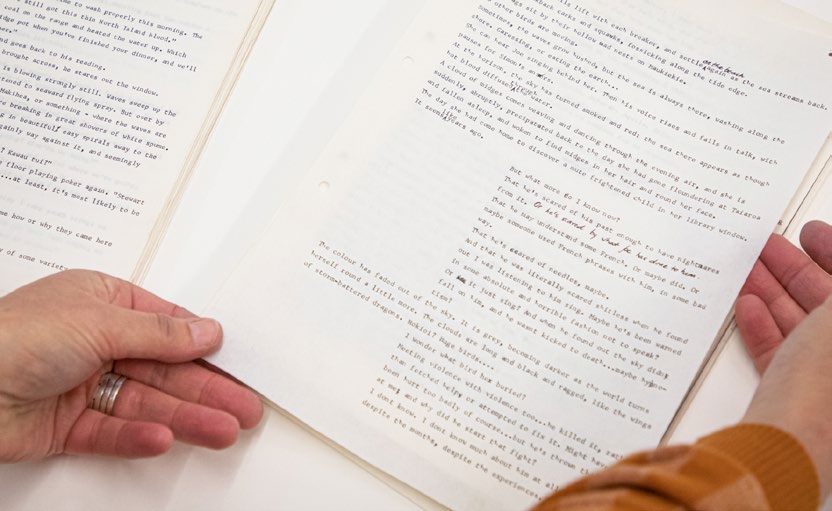
A page from the manuscript of the bone people, showing annotations by Keri Hulme. Ref: MS-Papers-12800-2
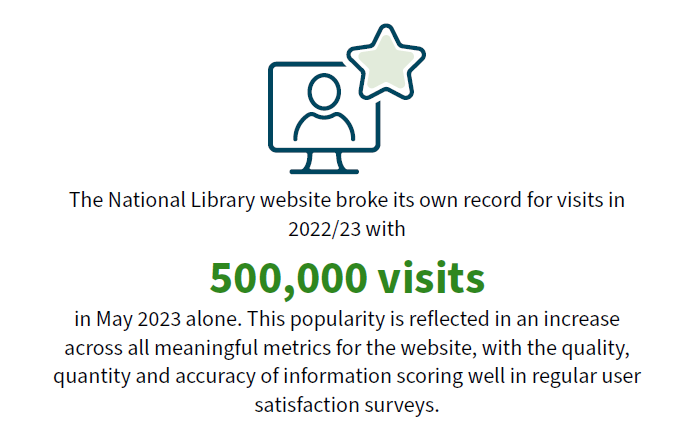
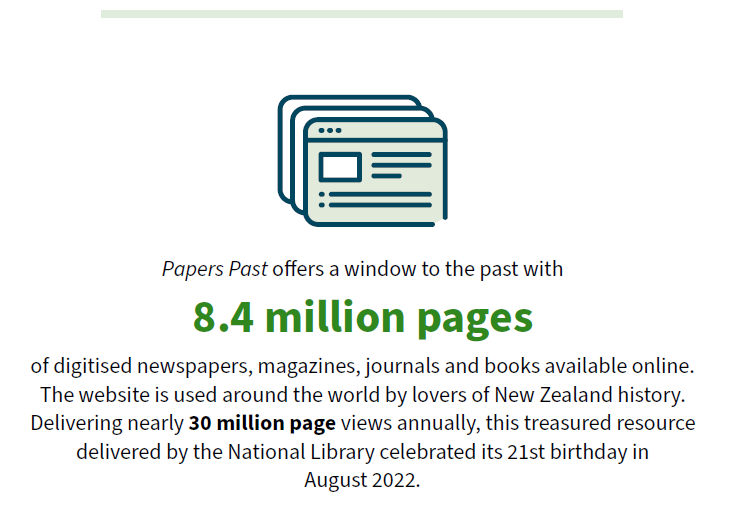
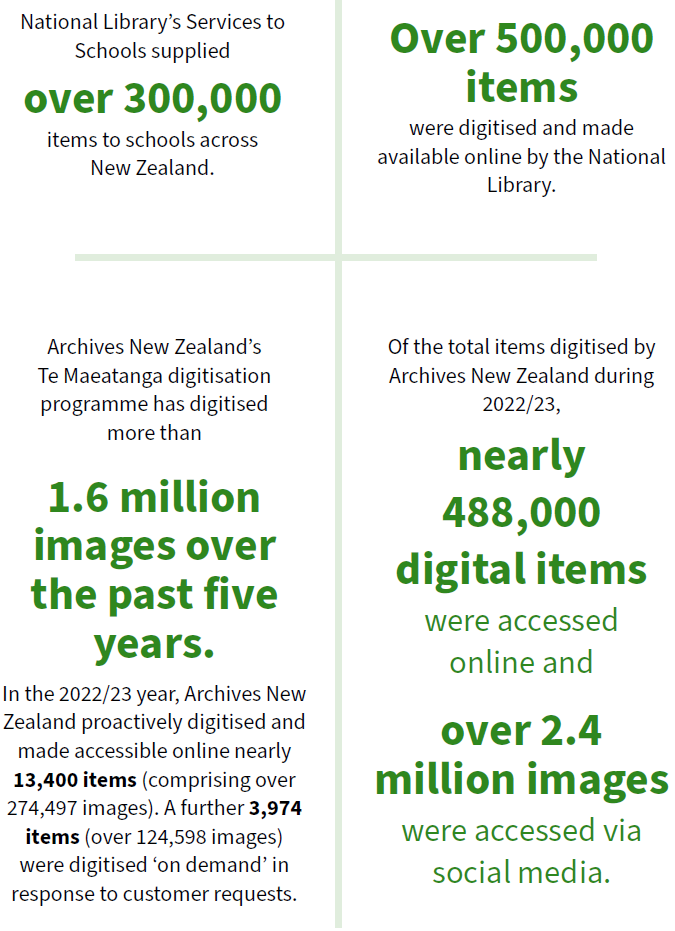
What are our outcome indicators telling us?
▶ Satisfaction with citizenship services is maintained or increases
|
Metric |
2018/19 |
2019/20 |
2020/21 |
2021/22 |
2022/23 |
Trend |
|---|---|---|---|---|---|---|
|
% |
90% |
90% |
90% |
84% |
88% |
|
Source: DIA Customer Experience Survey [1]
▶ People’s sense of belonging to New Zealand increases
|
Metric |
2018/19 |
2019/20 |
2020/21 |
2021/22 |
2022/23 |
Trend |
|---|---|---|---|---|---|---|
|
% |
No survey |
No survey |
Data not available [2] |
88% [3] |
Data not available [4] |
|
Source: General Social Survey – Stats NZ [4]
▶ 10-17-year-old New Zealanders read or started to read at least one book in the past 12 months is maintained or increases
|
Metric |
2018/19 |
2019/20 |
2020/21 |
2021/22 |
2022/23 |
Trend |
|---|---|---|---|---|---|---|
|
% |
No survey |
No survey |
No survey |
94% [5] |
No survey [6] |
|
Source: Read NZ – National Reading Survey [6]
The results for two of the outcome indicators for 2022/23 are not available due to changes in survey timings or the survey not being run during the year.
Citizenship is an important marker of people’s sense belonging in New Zealand. The high level of satisfaction with citizenship services shows that we are making the process as positive and engaging as possible for people acquiring citizenship. Over the past year we have improved the satisfaction with citizenship services. This improvement is most likely due to efforts in decreasing processing timeframes, improving clarity for customers, reducing manual work for staff and enhancing our automated checks.
People’s sense of belonging helps build cohesion and connection in communities
People’s sense of belonging also comes from a sense of cohesion in the community and connection to the local community. The Hāpai Hapori team within Te Tari Taiwhenua provides community development and advisory services to support hapū, iwi, community, and community organisations achieve their aspirations. This includes providing financial support through grants and connection to resources, services, other organisations, local government and central government.
During 2022/23, Hāpai Hapori completed over 9,000 advisory services and processed over 7,500 grants, which contributes to people having a sense of community cohesion. Hapū, iwi and communities continue to be connected and supported through funding community activities, new initiatives, organisations and supporting volunteers. An example is a grant made in January 2023 to the Mataura community to run a school holiday programme. Seventy-seven community children attended the programme, with 36 people volunteering their time. Parents were able to continue working, children were engaged in activities and well fed, and volunteers learnt new skills. The local Police indicated that they had fewer youth coming to their attention during this period. As a result of this initiative, an after school drop-in activity programme was set up.
A culture of reading enhances literacy and knowledge
Reading is a foundation for all literacies including digital literacy. Reading for pleasure, particularly for children, provides benefits such as literacy development, improved wellbeing and education, and employment success. Increases in literacy levels will improve creativity leading to new knowledge and potential innovation.
Te Puna Mātauranga o Aotearoa the National Library of New Zealand supports literacy through the Services to Schools programme. This programme provides nationwide services for school communities to improve literacy and learning through providing resources, building capability, enabling networks and cross-sector leadership. Services to Schools supports young people to grow a love of reading and strengthens connections to language, culture, interests and identity. It supports educators by providing professional learning, advice and quality resources that inspire and enrich learning and literacy across the curriculum. Services to Schools also provides expert support for the development of school libraries.
Since 2019, the National Library Pūtoi Rito Communities of Readers initiative has been working to build reading engagement and address inequity of access to books [7]. This initiative works with partners in communities across Aotearoa New Zealand to design, develop and deliver support to grow reading for pleasure and wellbeing for children and young people. The Canterbury Pūtoi Rito Communities of Readers project that ran from September 2020 to June 2023 is an example of this initiative. This project successfully delivered over 7,800 high-quality books in English, te reo and other home and heart languages (the first language someone speaks at home), including dual language books to children and young people in care and on the edge of care in the Canterbury region. The National Library collaborated with the Oranga Tamariki regional office, Kingslea School and social service agencies in Canterbury to successfully deliver this project.
Notes
1. The DIA Customer Satisfaction Survey is run annually by NielsenIQ on behalf of Te Tari Taiwhenua using a sample of customers who have used services in the previous 12 months. For the 2022/23 survey, a total of 16,995 customers were interviewed (across all services being surveyed) between 1 July 2022 and 1 June 2023. Further information on this survey can be found at https://www.dia.govt.nz/Customer-Experience-Survey.
2. The Stats NZ General Social Survey was delayed, so there were no results to report for the 2021/22 period.
3. The 2021/22 result was provided by Stats NZ as a customised data set from the Stats NZ 2021 General Social Survey covering the survey period 1 April 2021 to 17 August 2021. This measure is based on a scale where 0 is no sense of belonging and 10 is a very strong sense of belonging. The 2016/17 and 2021/22 results are based on the percentage of people aged 15 years and over who reported their sense of belonging to New Zealand at 7 or higher.
4. The Stats NZ General Social Survey is generally carried out every two years. The Stats NZ 2022 General Social Survey was delayed until 2023 and the results from this survey will not be available until mid-2024.
5. Read NZ report that the sample size was small with n=89. The result is slightly lower than in 2018 (97 percent) but the difference is not statistically significant.
6. This indicator is sourced from the Read NZ National Reading Survey and can be found at https://www.read-nz.org/resources/research. The survey is run approximately every two to three years. The last survey was run in 2021. The next Read NZ National Reading Survey will run in 2024. For 2022/23, we removed the indicator Adult New Zealanders read or started to read at least one book in the past 12 months is maintained or increases as it was no longer relevant.
7. Information on the Communities of Readers initiative can be found at www.natlib.govt.nz/putoirito.
Return to He papa whāinga - Our Outcomes Framework

Outcome:
He whenua manapori pai a Aotearoa, kāwanatanga mai, kaunihera ā-rohe mai
New Zealand is a well-functioning democracy across central and local government
About this outcome
Both central and local government have big impacts on the lives of New Zealanders and are an essential part of our democracy. Ensuring that government is accountable and transparent builds trust and confidence in central and local government and contributes to people’s willingness and ability to participate in society.
Cooperation and coordination across central and local government is critical to address complex issues that have both local and national implications and solutions.
Contributing to the achievement of this outcome we have four intermediate outcomes that represent more specifically the impact we will have:
- Executive Government functions well through support, services and advice
- Engagement between Māori and local government is strengthened
- Government transparency is upheld
- Local government works collectively to address national objectives.
Case study
Modernising All-of-Government ICT
Our aim
Our aim is to ensure that there is a future supply of Telecommunications as a Service (TaaS), Infrastructure as a Service (IaaS) and Cloud agreements, based on the needs of government agencies, and to increase the number of suppliers.
Our role
Te Tari Taiwhenua manages an All-of-Government portfolio of products and services that are used by over 300 agencies to support critical ICT operations.
The outcome
A comprehensive review of ICT telecommunications, infrastructure and Cloud services agreements within the portfolio was completed during 2022/23. This review concluded that agencies still required TaaS and IaaS agreements and would also benefit from new agreements.
These new agreements will provide continuity for agencies and certainty for suppliers beyond the end of the current agreements. The transition to new and more flexible agreements will allow for more services that will deliver innovation to agencies. They will also assist in increasing the number of suppliers that can provide services to the agencies.
What this means for New Zealanders
These changes will enable agencies to access modern and adaptive technology solutions to provide safe, secure, resilient public services to New Zealanders.
Supporting the engagement with rural and provincial councils
In mid-late 2022, Te Tari Taiwhenua supported the Associate Minister of Local Government on his engagement with rural and provincial councils. These visits enabled the Minister to hear directly from councils about their specific needs and concerns.
The issues shared by councils included water services reform, funding and financing pressures, transport and roading, housing shortages, climate change and local economic development.
This feedback informed the creation of a $44 million fund to retain and attract council staff, and a $10 million programme to support upgrades to rural water supplies. The feedback from councils also informed refinements to the Government’s reform programme to ensure it reflects local voices in rural and provincial communities.
Final report for the Future for Local Government review delivered in June 2023
On 23 April 2021, the Minister of Local Government had announced a Review into the Future for Local Government (the Review). The Review was requested by the local government sector to respond to the historical fiscal challenges and the range of reform happening in the sector, including changes to water services and the resource management system.
The independent Panel (the Panel) was tasked with identifying how our system of local democracy and governance needs to evolve over the next 30 years, to improve the wellbeing of New Zealand communities and the environment and actively embody the Treaty partnership. The Panel recommended a package of significant change that touches on all aspects of the local government system.
Te Tari Taiwhenua provided Secretariat support throughout the Review. The Secretariat included policy people who provided well-researched and evidence-based material from New Zealand and overseas for the Panel to consider in the formation of their ideas and recommendations. A Communication and Engagement team coordinated and supported face-to-face and online hui to ensure the Panel heard opinions directly from stakeholders across the motu.
Strengthening the response to future pandemics by setting up the Royal Commission of Inquiry Into COVID-19 Lessons
Te Tari Taiwhenua led the establishment of the Royal Commission of Inquiry Into Lessons Learned from New Zealand’s Response to COVID-19 That Should Be Applied in Preparation for a Future Pandemic. This involved:
- providing initial advice to Ministers to support their consideration of a COVID-19 inquiry
- advising on high-level budget considerations
- developing the Inquiry’s scope and terms of reference
- appointing Commissioners Professor Tony Blakely (Chair), Hon Hekia Parata and John Whitehead
- leading the operational set up for the Inquiry
- supporting the implementation of the monitoring and reporting requirements, which provide assurance to the Government that the Inquiry will deliver to its terms of reference on time and within budget.
The Inquiry is focused on capturing the lessons learned from the pandemic so New Zealand is prepared for the future. The Inquiry must deliver its report by 26 June 2024.
Supporting the Royal Commission of Inquiry into Historical Abuse in State Care and in the Care of Faith-based Institutions
The Royal Commission of Inquiry into Historical Abuse in State Care and in the Care of Faith-based Institutions, which was established in 2018, is the largest statutory Inquiry undertaken in New Zealand. Te Tari Taiwhenua has supported this work since the start and continues to provide advice on this Inquiry, including monitoring and assurance functions, as it approaches its conclusion.
In December 2022, Te Tari Taiwhenua supported the receipt and tabling of the Royal Commission’s Lake Alice Case Study Report ‘Beautiful Children’. This report is the first comprehensive record of abuse in care at the Lake Alice Child and Adolescent Unit.
The Royal Commission has completed its programme of public hearings and evidence gathering and is now focused on preparing its final findings and recommendations. Following recent changes to its terms of reference, the Royal Commission’s final report will be delivered by 28 March 2024.
Marking the change in Head of State
Upon the death of Queen Elizabeth II, Prince Charles III, the Prince of Wales, acceded as the King of New Zealand. A Proclamation of Accession ceremony was held on the steps of Parliament on Sunday 11 September 2022 for the public reading of the Proclamation of Accession for King Charles III.
New Zealand then formally marked the passing of Queen Elizabeth II with a State Memorial Service on 26 September 2022. The service, beginning with a National Minute of Silence, was a chance to celebrate her Majesty’s life and seven-decade reign as New Zealand's head of state. The day of the State Memorial Service was marked as a public holiday, to enable all New Zealanders to pay their respects and take part in the Service or in community events held across Aotearoa if they wished to.

Delivery snapshots
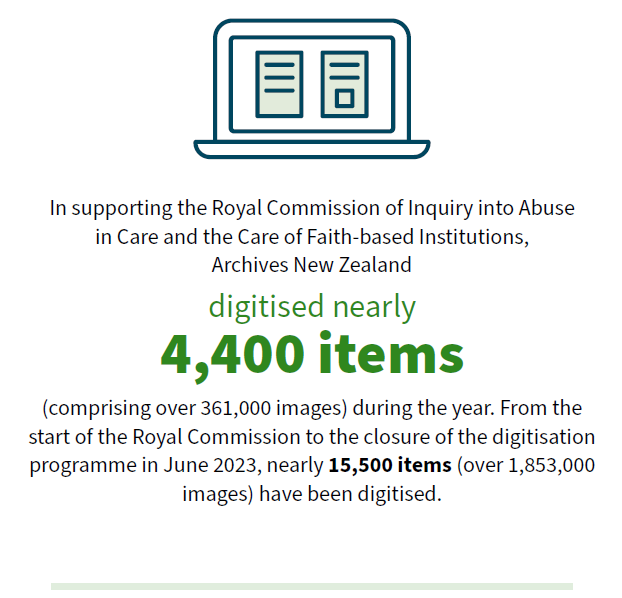
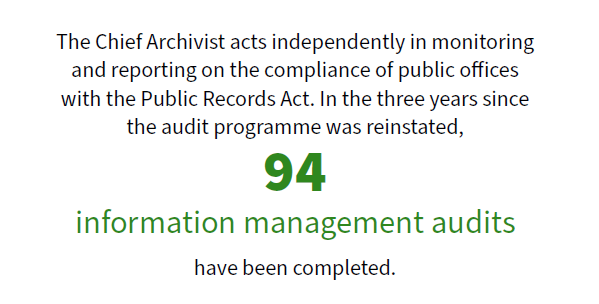
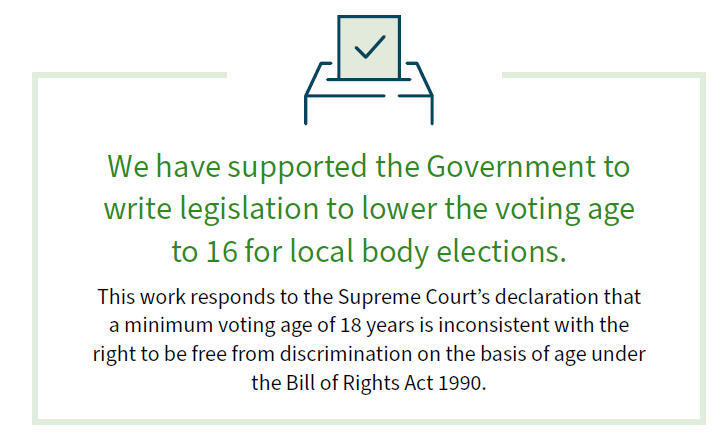
|
In supporting the appointment of Tauranga City Council Commissioners, Te Tari Taiwhenua:
|
|
In supporting the delivery of the 2022 local elections, Te Tari Taiwhenua:
|
What are our outcome indicators telling us?
▶ The level of institutional trust is maintained or increased
|
Metric |
2018/19 |
2019/20 |
2020/21 |
2021/22 |
2022/23 |
Trend |
|---|---|---|---|---|---|---|
|
% |
41% |
No survey |
58% [1] |
42% [2] |
Data not available [3] |
|
Source: General Social Survey – Stats NZ [3]
▶ Perceptions of corruption are maintained or decreased
|
Metric |
2018/19 |
2019/20 |
2020/21 |
2021/22 |
2022/23 |
Trend |
|---|---|---|---|---|---|---|
|
Score out of 100 |
87 (Rank = 2) |
87 (Rank = 1) |
88 (Rank = 1) |
88 (Rank =1) |
87 (Rank = 2) |
|
Source: Transparency International’s Corruptions Perceptions Index [4]
▶ New Zealand’s global ranking in the Democracy Index is maintained or increases
|
Metric |
2018/19 |
2019/20 |
2020/21 |
2021/22 |
2022/23 |
Trend |
|---|---|---|---|---|---|---|
|
Score out of 10 |
9.26 (Rank = 4) |
9.26 (Rank = 4) |
9.25 (Rank = 4) |
9.37 (Rank = 2) |
9.61 (Rank = 2) |
|
Source: The Economist’s Democracy Index [5]
▶ New Zealanders’ trust in public services based on personal experience is maintained or increases
|
Metric |
2018/19 |
2019/20 |
2020/21 |
2021/22 |
2022/23 |
Trend |
|---|---|---|---|---|---|---|
|
% |
79% |
Data not available |
81% |
81% |
82% |
|
Source: Kiwi Counts Survey – Public Service Commission [6]
Our indicators tell us that the level of trust from the New Zealand Parliament has been maintained. This is reflected internationally in Transparency International’s Corruptions Perceptions Index, where New Zealand remains one of the countries with the lowest perceived levels of corruption, ranking second equal in the world with Finland. While this is a slight decrease from last year, the longer-term trend shows New Zealand has maintained its position as number one or two in this index. This continues to be supported by The Economist’s Democracy Index as number two in the world, with a full democracy regime in place.
We are unable to report on the level of institution trust due to a change in the survey timing for this indicator. However, New Zealanders continue to hold a high level of trust in public services based on their personal experiences. In June 2023, the Public Service Commission reported that 82 percent of New Zealanders trust public services based in their personal experiences.
Notes
1. The data for the 2020/21 result was collected as part of a wellbeing supplement in the Statistics NZ Household Labour Force Survey (HLFS) rather than through the General Social Survey. The HLFS had differences in its collection method, sampled population, reporting periods and restrictions on face-to-face interviewing, among other things, that may affect comparability. This result is not able to be compared with the prior or current year’s results.
2. This result is from the Stats NZ 2021 General Social Survey covering the survey period 1 April 2021 to 17 August 2021. The 2021 General Social Survey can be found at https://www.stats.govt.nz/information-releases/wellbeing-statistics-2021.
3. The Stats NZ General Social Survey is generally carried out every two years. The 2022 survey was delayed until 2023 and the results will not be available until mid-2024.
4. Transparency International’s Corruptions Perceptions Index and results for all years can be found by visiting https://www.transparency.org/en/cpi/2022 and selecting the relevant year.
5. The 2022 Economist’s Democracy Index can be found at https://www.eiu.com/n/campaigns/democracy-index-2022.
6. The Kiwi Counts Survey can be found at https://www.publicservice.govt.nz/research-and-data/kiwis-count. We use the June quarter results.
Return to He papa whāinga - Our Outcomes Framework

Outcome:
Ka māmā noa tā te iwi whai wāhi ki ngā ratonga me ngā mōhiohio e hiahiatia ana
People can easily access the services and information they need
About this outcome
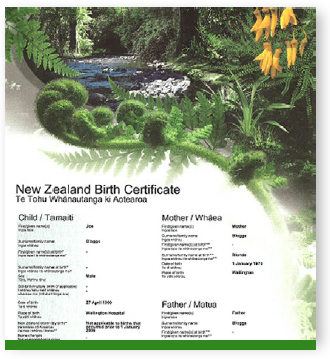 People’s ability to access services and information affects their lives and wellbeing.
People’s ability to access services and information affects their lives and wellbeing.
We work across government to identify opportunities to make services and information more easily accessible to those who need them.
Making it easy for people to verify their identity and reducing or eliminating digital barriers enhances people’s ability to participate in society – through jobs, education, community work and recreation.
Contributing to the achievement of this outcome we have four intermediate outcomes that represent more specifically the impact we will have:
- People’s identity can be easily and securely verified
- Barriers to digital inclusion are reduced
- People’s access to government is enhanced
- Taonga tuku iho rights are protected.
Case study
Improving online identity services to secure, validate and share information
Our aim
The Te Ara Manaaki programme is improving how people access and guard identity and life event services such as birth, death and marriage registrations, passports and citizenship.
Our role
Our role is to make it easier for our customers to access, use and change their identity and life event information, and to access services that support their connections with government and other service providers in their daily lives.
This is important because government-issued information supporting a person’s identity is the foundation for people’s safe and secure access to services. If people can easily and securely verify who they are, the risk of identity fraud decreases.
The outcome
During the year, we started designing and building the new platform for identity services that underpin the new civil registration and citizenship registration systems. These modern systems can more easily integrate with identity services to secure, validate and share information.
We also introduced new tools online to help people take photos that meet the technical standards when using the online identity checking feature, such as the photo editor and photo quality checker. This editor assists in limiting opportunities for people to alter photos in a misleading manner.
What this means for New Zealanders
Te Ara Manaaki will enable services to be delivered in a secure, more joined up, effective way – providing digital self-service options to customers and other agencies. This will maintain our customers’ trust and confidence that their life event information is correct, stored safely and accessed securely.
Self-identification makes it easier to amend registered sex on a New Zealand birth certificate
On 15 June 2023, a new administrative self-identification process to amend registered sex on a New Zealand birth certificate was introduced.
The self-identification process offers a more accessible and inclusive way to amend the sex registered on a New Zealand birth certificate. This new process will enable people to apply directly to the Registrar-General by submitting a statutory declaration to amend their registered sex to male, female or non-binary. This replaces the previous requirement where applicants were required to apply to the Family Court and provide proof of medical treatment.
The self-identification process will make a real difference for transgender, non-binary, takatāpui and intersex New Zealanders who will be able to have evidence of their identity that aligns with who they are. After the law was enacted, in the following two weeks we received 128 applications from New Zealanders seeking to use this process.
Digital Identity Services Trust Framework Act helps to protect the privacy and security of sharing people’s information online
The Digital Identity Services Trust Framework Act 2022 was passed in April 2023 and will come into effect on 1 July 2024.
The framework will make it easier for people to access information about themselves, and to share it securely with service providers when applying online for services. For example, activities such as online banking, claiming a welfare payment or opening a utilities account online require people to present identity documents like a birth certificate. This framework will allow a person to nominate the piece of information and provide permission for the holder of that information to share it with these service providers. People will still be able to apply for services in person, over the phone, or by using physical credentials.
There are clear rules for how personal and organisational information can be handled when sharing information within the new framework. The new identification management standards underpin this framework to help prevent identity theft, fraud and loss of privacy.
Reducing social isolation by connecting people in remote parts of the region
Tararua REAP, an educational service provider based in Dannevirke, identified the need for people to come together in remote parts of the region to reduce social isolation and loneliness during the COVID-19 pandemic.
A digitally-enabled mobile cabin was funded through the Lottery funding to enable support to the rural community around Tararua. This mobile cabin was made available to other community groups and was used to support rural events, mental health support activities, provide budget advice and carry out educational programmes for local schools.
This helped to connect people and ensure isolated rural communities can access the services they need.
Empowering Pacific peoples to connect to their digital heritage
The Pacific Virtual Museum project aims to empower people in and of the Pacific Islands, enabling them to see, discover and explore items of digitised cultural heritage that are held in collections around the world.
The Pacific Virtual Museum team have visited different islands around the Pacific from Saipan to Rarotonga to showcase the digitalpasifik.org site, and to learn from users in the Pacific how it can be more useful. One of our main areas of focus is to demonstrate the website to current associates and schools, which led to opportunities to onboard new content partners.
We have seen the potential of the digitalpasifik.org site as a tool for education in New Zealand, especially with Pacific Studies soon to be included in the curriculum, as well as a new resource that local Pacific communities use.
Uhi Tai – Putting the customer at the centre
Over the next five years, there will be a significant increase in the number of passport and citizenship applications we receive from our customers. To respond to this, we introduced an organisational development plan for life and identity services kaimahi. Uhi Tai (The Workforce Project) is a part of this organisational development plan that focuses on ensuring we have kaimahi with the rights skills available to respond to that increased customer demand. This includes developing strategies to guide our learning and recruitment, and a data model that quantifies our staffing requirements over the long term.
Uhi Tai will enable us to ensure we are consistently meeting the needs of our customers across our products and services. We are refining learning pathways for kaimahi, re-designing our learning approach, and implementing a capability framework to support development. This means that kaimahi are prepared well in advance to put the customer at the centre and ensure that Te Tari Taiwhenua delivers service excellence every day.
Case study
Using the Privacy Maturity Assessment Framework to improve privacy maturity across government
Our aim
The Privacy Maturity Assessment Framework (PMAF) helps agencies understand their current level of privacy maturity in managing personal information and identify where they can improve. It assists the Government Chief Privacy Officer (GCPO) to provide support to agencies in uplifting their privacy maturity and capability.
Our role
The GCPO leads an All-of-Government approach to privacy to raise public sector privacy maturity and capability. The connection between good privacy practice, public trust and the quality of the services that the government delivers is critical to ensure that public services are trusted and accessible by those who need them.
The outcome
Every year, public service agencies use the GCPO’s PMAF to report on their current state of privacy maturity.
In 2022, 44 agencies submitted reports under the newly released PMAF to represent a new baseline for privacy maturity. Most agencies reported their privacy level as Foundational, which means that an agency-wide approach to privacy is developing. The system-level insights from the PMAF results are published on www.digital.govt.nz to allow the public to see how the system is performing, and whether privacy maturity is improving from year to year.
A new way of reporting was introduced where agencies can identify their strengths and weaknesses. This will provide GCPO with better information about what agencies are doing to protect privacy and will also help to identify target areas for improvement across government to uplift privacy maturity.
What this means for New Zealanders
The New Zealand public expect government agencies to carefully look after their personal information while meeting the legal obligations under the Privacy Act 2020. The improvement in privacy maturity helps increase trust and confidence in the public sector and this, in turn, helps more people to easily access the services and information they need.
Delivery snapshots
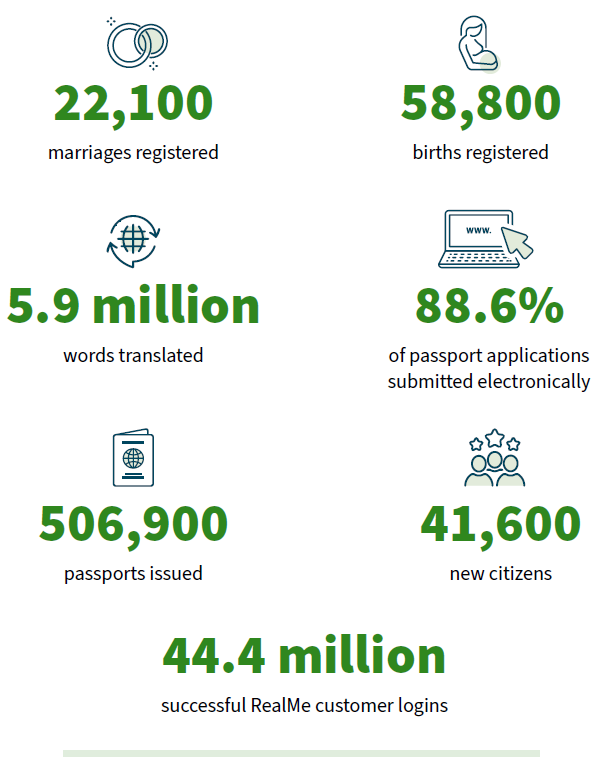
The Aotearoa People’s Network Kaharoa (APNK) service has played a key role in supporting communities affected by the COVID-19 pandemic and natural disasters by offering easy access to key information and online resources and services. APNK delivers free, secure internet access to New Zealanders through public libraries in 57 district councils.
More than 7,000 people use the service daily.
What are our outcome indicators telling us?
▶ Ease of getting passport services is maintained or increases
|
Metric |
2018/19 |
2019/20 |
2020/21 |
2021/22 |
2022/23 |
Trend |
|---|---|---|---|---|---|---|
|
% |
86% |
86% |
90% |
89% |
89% |
|
Source: DIA Customer Experience Survey [1]
▶ Ease of getting birth, death and marriage services is maintained or increases
|
Metric |
2018/19 |
2019/20 |
2020/21 |
2021/22 |
2022/23 |
Trend |
|---|---|---|---|---|---|---|
|
% |
86% |
91% |
91% |
92% |
90% |
|
Source: DIA Customer Experience Survey [1]
▶ Ease of getting citizenship services is maintained or increases
|
Metric |
2018/19 |
2019/20 |
2020/21 |
2021/22 |
2022/23 |
Trend |
|---|---|---|---|---|---|---|
|
% |
87% |
88% |
89% |
86% |
89% |
|
Source: DIA Customer Experience Survey [1]
▶ People’s trust and confidence in digital identity is improved
|
Metric |
2018/19 |
2019/20 |
2020/21 |
2021/22 |
2022/23 |
Trend |
|---|---|---|---|---|---|---|
|
% |
91% |
94% |
93% |
88% |
87% |
|
Source: DIA Customer Experience Survey [1]
Our indicators continue to show high levels of satisfaction with ease of access to or use of key services from Te Tari Taiwhenua. These services include issuing of passports, birth, death and marriage registration and the processing of citizenship applications. The result for the indicator of ease of getting citizenship services increased by 3 percent over the past year, most likely due to improved processing timeframes for citizenship applications. While the result for the indicator ease of getting birth, death and marriage services decreased by 2 percent over the past year this is not considered to be significant. The overall trend shows that this ease is being maintained.
We continue to see a high proportion of people express trust and confidence in digital identity. However, the longer-term trend shows that this trust and confidence is starting to decline. Trust and confidence among passports and citizenship customers each increased by 1 percent from 2021/22. However, trust and confidence among births, deaths and marriages customers decreased by 5 percent from 2021/22. This decrease may be due to changes made to improve how representative the survey is of all customers. We will continue to monitor the future trend of trust and confidence.
Note
1. The DIA Customer Satisfaction Survey is run annually by NielsenIQ on behalf of Te Tari Taiwhenua using a sample of customers who have used services in the previous 12 months. For the 2022/23 survey a total of 16,995 customers were interviewed (across all services being surveyed) between 1 July 2022 and 1 June 2023. Further information on this survey can be found at https://www.dia.govt.nz/Customer-Experience-Survey.
Return to He papa whāinga - Our Outcomes Framework

